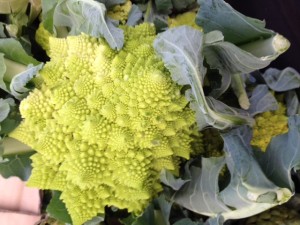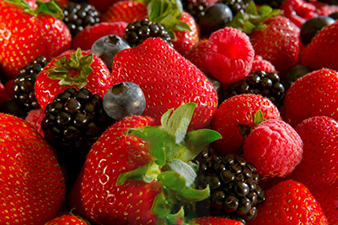Foods That Keep Those Joints Jumpin’

Spring is here, the days are longer and it’s time to get active. My busy schedule makes it challenging to find time to exercise, but luckily the weather in Southern California makes it easy to get outside year-round. Lately, I have been swimming almost every day and taking walks whenever I can. If the thought of picking up that tennis racquet or tying on those hiking boots makes you dread achy knees and shoulders, start thinking about how what you eat can help protect your joints and other moving parts.
The most common source of joint pain is arthritis. According to Web MD, there are many types of arthritis, but two are the most common. Osteoarthritis is a degenerative condition caused by the normal wear and tear on joints over a lifetime. Rubbery tissue called cartilage cushions the joints so they move smoothly, but over time the cartilage can wear away from overuse. Obesity and age also contribute to the degeneration of joints. Rheumatoid arthritis is a chronic autoimmune disease where the body’s defenses attack itself, in this instance, cartilage surrounding the joints. Unlike osteoarthritis, rheumatoid arthritis presents in both sides of the body—both knees, both hips, etc. RA is thought to be caused by a combination of factors including genetics, environmental conditions and hormones.
The good news is that there are many foods that can help prevent or slow the progress of arthritis, all of which are delicious and lend themselves to tasty, healthful meals.
Omega-3 fatty acids – Found in wild salmon (fresh or canned) and other oily fish such as sardines, mackerel and trout. Almonds, flaxseeds, walnuts and olive oil are also good sources.
 Broccoli – The family of cruciferous vegetables includes broccoli (see my Tofu & Vegetable Stir Fry), cauliflower and the beautiful romanesco. These nutritional powerhouses contain high levels of sulforaphane which may boost the body’s defenses against free radicals according to a 2008 UCLA study that appeared in the Journal of Allergy and Clinical Immunology. Free radicals can interfere with healthy cell function. Broccoli offers a number of important vitamins that keep joints well nourished – A, Bs, C, E and K. As a bonus, broccoli contains a good dose of bone-strengthening calcium. Steamed, roasted or stir fried, broccoli “plays well’ with any number of colorful, nutritious vegetables.
Broccoli – The family of cruciferous vegetables includes broccoli (see my Tofu & Vegetable Stir Fry), cauliflower and the beautiful romanesco. These nutritional powerhouses contain high levels of sulforaphane which may boost the body’s defenses against free radicals according to a 2008 UCLA study that appeared in the Journal of Allergy and Clinical Immunology. Free radicals can interfere with healthy cell function. Broccoli offers a number of important vitamins that keep joints well nourished – A, Bs, C, E and K. As a bonus, broccoli contains a good dose of bone-strengthening calcium. Steamed, roasted or stir fried, broccoli “plays well’ with any number of colorful, nutritious vegetables.
Olive Oil – By switching to fragrant olive oil, you’ll enjoy many of the benefits of the Mediterranean diet, which is plant-based with small amounts of fish and lean protein and olive oil as the primary fat. Olive oil’s anti-inflammatory properties are attributed to oleic acid, which contains polyphenols and omega-3 fatty acids, both of which are antioxidants. Use extra virgin olive oil, balsamic vinegar and herbs to create your own dressings. Use regular olive oil for cooking and sautéing—try preparing fried or scrambled eggs in olive oil instead of butter. For a tasty salad dressing with olive oil, try my Honey-Lime Dressing recipe.
Ginger and Turmeric – For centuries, people have been taking advantage of ginger’s medicinal properties as well as its bright, refreshing flavor in cooking. Useful for soothing nausea and migraines, ginger contains compounds called gingerols which act very much like non-steroidal anti-inflammatory drugs. Although not proven as a joint pain reliever, the Journal of Medicinal Food suggests that ginger has anti-inflammatory and antioxidant properties. Add fresh grated ginger to marinades for meat, chicken or fish. Also delicious grated into cookies, cakes or muffins. Turmeric is in the ginger family and is also high in antioxidants. A 2006 University of Arizona study cites that turmeric is one of the most potent natural anti-inflammatories available. It goes on to say that using turmeric to help treat rheumatoid arthritis can result in a reduction of painful symptoms. My recipes for Turkey in Turmeric Sauce and Turmeric Juice are delicious ways to add turmeric to your diet.
NOTE: Ginger acts as a blood thinner, which could interact with blood thinning medication. Check with your physician before adding ginger to your diet.
Vitamin C – Rather than popping supplements which can irritate the stomach and in high doses aggravate symptoms of arthritis, get your vitamin C from antioxidant-packed food sources such as kidney beans, oranges, papaya (see my Grilled Swordfish recipe with Papaya Salsa), bell peppers, mangos, strawberries (see my Immunity Boosting smoothie recipe) and pineapple. A 2004 study published in the Annals of Rheumatic Diseases suggests that greater intake of vitamin C is associated with a reduced risk of developing rheumatoid arthritis. A fruit salad made with all the above tossed with a lime-ginger dressing is a delicious way to get a healthy dose.
Cherries, blackberries, raspberries, strawberries (see Strawberry-Avocado Relish), grapes, and eggplant – The intense reddish color of these fruits indicates the presence of anthocyanidins which are potent antioxidants and free radical fighters. Studies associate these foods with cardiovascular health, but these same properties have been shown that they may help reduce arthritis inflammation as well. Treat yourself to a luscious salad of grapes, cherries and berries. For something savory, brush thin slices of eggplant with a little olive oil, top with marinara sauce (full of the antioxidant Lycopene), a sprinkling of Parmesan cheese and bake in a 375° oven for 15 minutes. Who needs pizza?
Sweet peppers, squash, pumpkin, orange sweet potatoes, papayas, tangerines, collard greens, and apricots – All these foods contain considerable amounts of beta-cryptoxanthin, a powerful antioxidant related to beta-carotene found in carrots. Beta-cryptoxanthin is converted to vitamin A in the body and may help prevent inflammatory diseases such as rheumatoid arthritis. According to researchers from the United Kingdom, their findings suggested a link between people who consumed more foods containing beta-cryptoxanthin and better protection against arthritis. For a hearty side dish, toss chunks of sweet potato, squash, pumpkin and sweet peppers in a little olive oil and roast in the oven at 400° for 25-30 minutes.
A big part of keeping joints healthy is as simple as eating right and making moderate daily exercise a habit. Aim for a diet high in fruits, vegetables, nuts and legumes while minimizing intake of red meat, dairy, saturated fats and simple sugars. By following these suggestions you’ll increase a sense of well-being while decreasing your chances of developing arthritis-related inflammation and pain.

